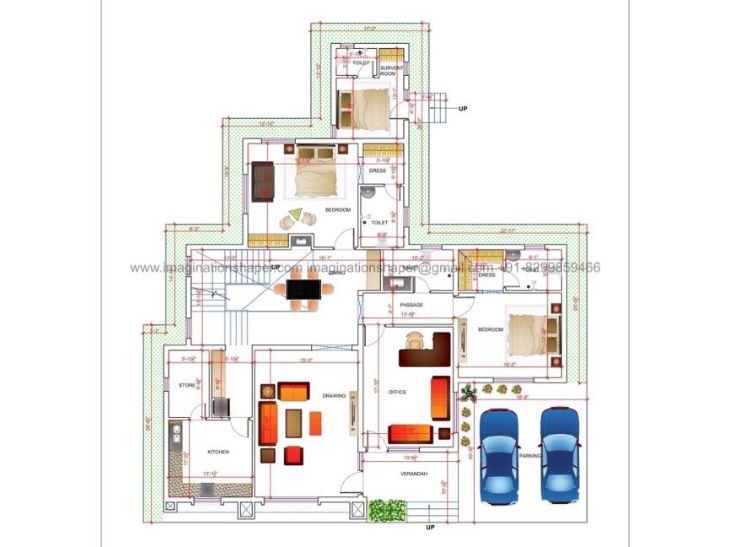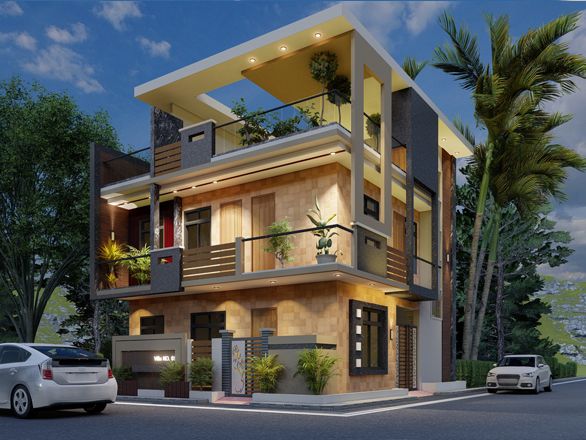
We'll be exploring 6 essential tips from an experienced architect that will help you maximize the potential of your house plan with elevation. From selecting the right materials to considering different elements of design, this post is sure to provide you with the information you need to make the most of your house plan. So read on to discover our top 6 tips for house plan with elevation!
When designing your house plan and elevation, it’s important to create a focal point that reflects your style and the architectural vision of your building. A focal point is something that stands out from the rest of the design, drawing the eye and creating an interesting visual aesthetic. It could be a single window, an exposed beam, or a sculptural element. Whatever it is, it should be incorporated into the overall building plan and elevation in a way that complements the rest of the design.
When creating a focal point in your house plan with elevation, consider the architecture of the structure. The focal point should be in proportion to the rest of the structure, and its placement should be considered with respect to other elements in the building plan and elevation. Additionally, try to create contrast between the focal point and its surroundings. This could be done by choosing a different texture or material, or by making the focal point larger or smaller than other elements in the design.
When it comes to designing a house plan with elevation, practicality should always be top of mind. It’s important to take the time to think about how the building plan and elevation will be used in everyday life.
It is also important to consider the amount of energy and resources that will be used in the house plan with elevation. Think about how you will light and heat your home, as well as how much water you'll need. If possible, try to design the building plan and elevation in such a way that reduces energy costs. Make sure that windows are placed strategically so that they can take advantage of natural light.
When prioritizing practicality in a house plan with elevation, it is important to take into consideration the use of space.
When designing a building plan with elevation, it’s important to consider how the landscaping can be used to your advantage. By adding vegetation, trees and other plants, you can create a more inviting outdoor space that complements the building plan and elevation. Think about incorporating hardscaping features such as walls, terraces and pathways to define outdoor living areas and add visual interest. You can also use native or drought-tolerant plants to reduce the amount of water and maintenance needed. Additionally, adding landscaping around your home can help to reduce noise from nearby roads and also provide insulation to keep your home cooler in the summer and warmer in the winter.
When it comes to your house plan with elevation, investing in quality insulation is essential. Insulation helps to regulate the temperature of your building and keep energy bills low. For example, high-quality insulation can help reduce the transfer of heat from inside your home to the outside, preventing heat loss or gain depending on the season. Quality insulation also helps dampen sound, creating a quieter and more comfortable environment for you and your family.
When choosing insulation for your house plan with elevation, you should consider how much it will cost and what type best meets your needs. You may want to look at factors such as the R-value (the measure of thermal resistance) and U-value (the measure of thermal transmittance). With so many insulation types available, it is important to research and understand which type works best for your building plan and elevation.
When designing a house plan with elevation, thermal mass is one of the most important considerations. Thermal mass is a material that absorbs and stores heat energy. It helps to regulate the temperature inside the building, reducing the need for artificial heating and cooling.
Using thermal mass in a building plan and elevation can be beneficial in many ways. It helps to keep temperatures stable throughout the day, which means it can reduce energy costs associated with air conditioning and heating. It also helps to reduce the amount of noise entering the building and provides additional insulation, improving overall comfort levels.
When selecting materials for your house plan with elevation, look for those that have a high thermal mass. Examples of materials that can provide effective thermal mass include concrete, brick, stone and tile. When used in an appropriate way, these materials can help to moderate temperatures, keeping them comfortable all year round.
When it comes to your house plan with elevation, using green materials can help reduce the environmental impact of your building plan and elevation. Green materials offer many benefits such as increased energy efficiency, improved air quality, reduced water consumption and minimized construction waste. They can also add value to your home and help you save money in the long run.
When selecting green materials for your house plan with elevation, be sure to consider the following:
• Energy efficiency: Look for insulation products that are designed to reduce energy consumption and improve indoor comfort.
• Indoor air quality: Choose low-emitting products and paints to reduce indoor air pollutants and improve overall air quality.
• Water conservation: Select fixtures and appliances that use less water.
• Construction waste: Choose products with minimal packaging and recycling options.
Creating a house plan with elevation is a major undertaking and requires thoughtful consideration. Following the tips from an architect can help make sure that your building plan and elevation meet both form and function. Prioritizing practicality, landscaping, insulation, thermal mass, and green materials can help you create a house plan with an elevation that is both efficient and attractive. With the right preparation, you can create a building plan and elevation that meets all of your needs.

Get best customized house plan designed by experienced architects and designers.

Are looking for the elevation design services, Imagination would be the perfect option.

Home interior design to enhance the interior of the project services at an affordable price.

Design your health care project as per guidelines, the user and patient-centric also.

We incorporate sustainability strategies, creative space planning and best technology.

We are focused on combining function with style to meet the need of businesses.

